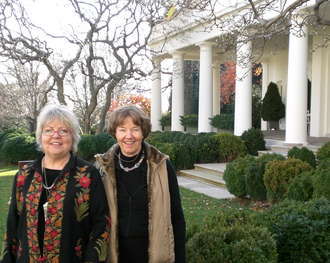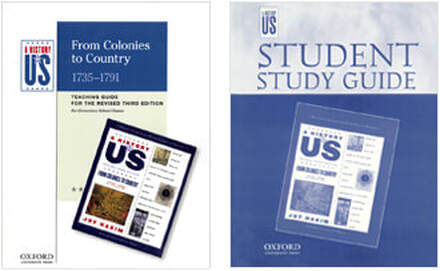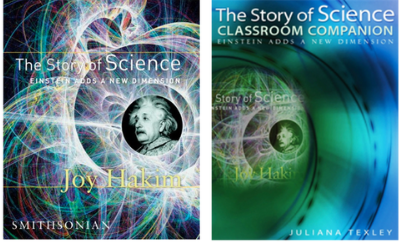Teaching Resources
A History of US and The Story of Science are intended to teach reading comprehension as well as subject matter. Make believe stories are a great way to teach beginning reading. Some first graders really believe that rabbits can talk. We need to cherish and build on that moment in their development. But we live in an Information Age, nonfiction dominates today’s adult reading. It may be time for school curricula to consider well-written narrative nonfiction as the core of school reading instruction, especially from 5th grade up.
Dallas teacher Barbara Dorff was asked if she would teach reading to a class of 5th graders who tested at the bottom of the academic barrel (many were ESL students). She agreed, if she could pick the class reading book. She chose Book 8 from A History of US (the robber baron era).
Then, being a skilled teacher, she did upfront activities with the class. She had them define words and she prepared them with background on what they would be reading. The class read a chapter and Dorff tested them on comprehension and gave them their tests back. She asked if any of them had ever seen a movie more than once. Did they notice things they had missed on the first viewing? “Reading can be like that,” she said, and had them read the same chapter again, this time looking for things they missed on the first read. She tested them again and returned their tests. She told them that scientists, engineers and lawyers often read documents many times to make their meaning clear. She had her fifth graders read each chapter four times.
What happened? At the end of the year class reading scores rose 10, and 12, and 14% and Dorff was named Texas Teacher of the Year.
Then, being a skilled teacher, she did upfront activities with the class. She had them define words and she prepared them with background on what they would be reading. The class read a chapter and Dorff tested them on comprehension and gave them their tests back. She asked if any of them had ever seen a movie more than once. Did they notice things they had missed on the first viewing? “Reading can be like that,” she said, and had them read the same chapter again, this time looking for things they missed on the first read. She tested them again and returned their tests. She told them that scientists, engineers and lawyers often read documents many times to make their meaning clear. She had her fifth graders read each chapter four times.
What happened? At the end of the year class reading scores rose 10, and 12, and 14% and Dorff was named Texas Teacher of the Year.
So, does A History of US belong in social studies or language arts classes? Both. Or either. That’s for you to decide, but consider that they are intended as reading books that will give your students background in history that should help them understand current issues.
As for science, we’ve made it a discipline taught through one experiment after another. The experiments may be fun and enlightening, but the big ideas behind them are often left out. What is heat? An American traitor (he stuck with the British during the Revolutionary War ) figured that out and became an important figure in world history and in science history too. (Check out “Newton At the Center” to read his surprising story.)
We all love novels, poems, and science fiction too. But this is the Information Age and it may be time to look at the balance and time allotted to school subjects, especially in reading instruction.
I was a teacher and had a hard time with some of the walls I found between subjects. And with the often vacuous texts. So it seemed basic. We need to merge reading and subject matter using compelling narrative nonfiction. I believe both will profit.
With A History of US you have a choice of workbooks: from professionals at Oxford University Press (led by Susan Buckley) and/or from educator teams at Johns Hopkins University (led by Maria Garriott).
As for science, we’ve made it a discipline taught through one experiment after another. The experiments may be fun and enlightening, but the big ideas behind them are often left out. What is heat? An American traitor (he stuck with the British during the Revolutionary War ) figured that out and became an important figure in world history and in science history too. (Check out “Newton At the Center” to read his surprising story.)
We all love novels, poems, and science fiction too. But this is the Information Age and it may be time to look at the balance and time allotted to school subjects, especially in reading instruction.
I was a teacher and had a hard time with some of the walls I found between subjects. And with the often vacuous texts. So it seemed basic. We need to merge reading and subject matter using compelling narrative nonfiction. I believe both will profit.
With A History of US you have a choice of workbooks: from professionals at Oxford University Press (led by Susan Buckley) and/or from educator teams at Johns Hopkins University (led by Maria Garriott).
|
See these sample chapters from the Teacher's Guide and Student's Study Guide for Book 3: From Colonies to Country (1735-1791)
(A History of US) These study guides are academic resources intended to be used in conjunction with classroom work and reading assignments, they aid in mastering material and increase comprehension. A History of US is most often read in 5th and 8th grades (because of state curriculum requirements). The Oxford study guides are often chosen by 5th grade teachers and the Johns Hopkins materials by 8th grade. But this can vary. |
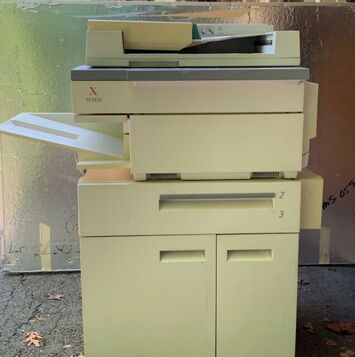 Old Xerox machine
Old Xerox machine
READING, WRITING, INTERDISCIPLINARY TEACHING (well, I can dream...)
Imagine if every teacher assigned some daily writing.
Writing demands thinking and that's what all of our students need to do well.
As a classroom teacher I had my students do daily writing. They self-published books (in a day when that meant using a Xerox machine). We gave the small books ISBN numbers and put them in the school library. ("We" acknowledges that I had help. Parents--the right ones--can be wonderful helpers.) One year another teacher and I collaborated, we had our 5th grade students do a literary journal based on their research. Today, if I were teaching with A History of US or the Story of Science I'd try to have my students do daily writing that involved research (the web makes it easily available) and ask them to turn their research into nonfiction narratives, or poems, or fictional journals. In other words, I'd have them compose stories drawn from the truth.
Imagine if every teacher assigned some daily writing.
Writing demands thinking and that's what all of our students need to do well.
As a classroom teacher I had my students do daily writing. They self-published books (in a day when that meant using a Xerox machine). We gave the small books ISBN numbers and put them in the school library. ("We" acknowledges that I had help. Parents--the right ones--can be wonderful helpers.) One year another teacher and I collaborated, we had our 5th grade students do a literary journal based on their research. Today, if I were teaching with A History of US or the Story of Science I'd try to have my students do daily writing that involved research (the web makes it easily available) and ask them to turn their research into nonfiction narratives, or poems, or fictional journals. In other words, I'd have them compose stories drawn from the truth.
Engaging lessons accompany specific volumes in Joy Hakim's books, A History of Us
To order JOHNS HOPKINS TEACHING MATERIALS for A History of Us, go to Amazon.com and enter the title of the A History of Us volume you are working with and either “Teaching Guide” or “Resource Book.” You will need both for a complete curriculum. For example, type “Liberty for All Teaching Guide” or “Liberty for All Resource Book.” This will result in multiple versions of teaching materials, so make sure you order the Johns Hopkins materials (blue cover).
To order JOHNS HOPKINS TEACHING MATERIALS for A History of Us, go to Amazon.com and enter the title of the A History of Us volume you are working with and either “Teaching Guide” or “Resource Book.” You will need both for a complete curriculum. For example, type “Liberty for All Teaching Guide” or “Liberty for All Resource Book.” This will result in multiple versions of teaching materials, so make sure you order the Johns Hopkins materials (blue cover).
Liberty for All? Resource Book by Susan Dangel et al.
The Johns Hopkins University Talent Development Secondary program has created outstanding teaching materials for each book in Joy Hakim’s award-winning A History of US series. A Teaching Guide for each volume includes twenty-five lessons and five review lessons. Each lesson includes background information for the teacher; focus activities; strategies for interactive teaching and cooperative learning; writing activities; homework assignments; and interdisciplinary extension activities. Each Teaching Guide’s accompanying Resource Book includes duplication masters for transparencies; review game cards and answer sheets; assessments; and student sheets and team sheets for all activities. The curriculum makes extensive use of primary source documents. “The coordinated teaching and learning materials from Johns Hopkins are just plain wonderful. I feel mighty lucky to have them reinforce and extend my books.” Joy Hakim
The Johns Hopkins University Talent Development Secondary program has created outstanding teaching materials for each book in Joy Hakim’s award-winning A History of US series. A Teaching Guide for each volume includes twenty-five lessons and five review lessons. Each lesson includes background information for the teacher; focus activities; strategies for interactive teaching and cooperative learning; writing activities; homework assignments; and interdisciplinary extension activities. Each Teaching Guide’s accompanying Resource Book includes duplication masters for transparencies; review game cards and answer sheets; assessments; and student sheets and team sheets for all activities. The curriculum makes extensive use of primary source documents. “The coordinated teaching and learning materials from Johns Hopkins are just plain wonderful. I feel mighty lucky to have them reinforce and extend my books.” Joy Hakim
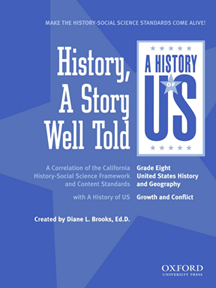
History, a Story Well Told by Diane L. Brooks, Oxford University Press
Diane Brooks is California's much respected former social studies chief. In this document, available in pdf format by clicking on the hyperlink below, you can see how she links the history books to state standards. But she does far more than that. This is a valuable document for teachers and other educators who want insights on teaching American history from an expert. If you're involved in setting state standards you will want to read this.
A correlation of A History of US with the current NORTH CAROLINA standards is available.
Diane Brooks is California's much respected former social studies chief. In this document, available in pdf format by clicking on the hyperlink below, you can see how she links the history books to state standards. But she does far more than that. This is a valuable document for teachers and other educators who want insights on teaching American history from an expert. If you're involved in setting state standards you will want to read this.
A correlation of A History of US with the current NORTH CAROLINA standards is available.
Lesson Plans, Teaching Guides and Study Guides - The Story of Science
I'll Take Manhattan, U.S. History lesson plan written by master teachers Barbara Dorfff and Tamala Grikpingo
Adapted from A History of US, Book Two: Making Thirteen Colonies
I'll Take Manhattan: A History of US Book Two, Making Thirteen Colonies Lesson Plan
Lesson Plan by Barbara Dorfff and Tamala Grikpingo
Adapted from A History of US, Book Two: Making Thirteen Colonies
I'll Take Manhattan: A History of US Book Two, Making Thirteen Colonies Lesson Plan
Lesson Plan by Barbara Dorfff and Tamala Grikpingo
NSTA Teaching Materials for Einstein Adds A New Dimension
The science workbooks done at Johns Hopkins are special. I especially love the illustrations by Erin Pryor Gill, who not only is a terrific artist, he has a great sense of humor. Teaching materials for "Einstein Adds A New Dimension" at NSTA by President Emerita Juliana Texley. How do you each quantum theory in a classroom Texley manages it brilliantly. When you coordinate stories with hands on science you have a tale to remember that helps give meaning and purpose to lab work.
The science workbooks done at Johns Hopkins are special. I especially love the illustrations by Erin Pryor Gill, who not only is a terrific artist, he has a great sense of humor. Teaching materials for "Einstein Adds A New Dimension" at NSTA by President Emerita Juliana Texley. How do you each quantum theory in a classroom Texley manages it brilliantly. When you coordinate stories with hands on science you have a tale to remember that helps give meaning and purpose to lab work.
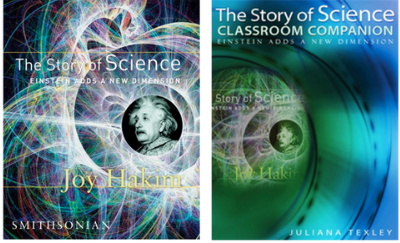
The Story of Science sample NSTA lesson plans
Einstein Adds a New Dimension brings to life the history of Albert Einstein and his fellow scientists as they lay the groundwork for concepts of particle physics and quantum mechanics.
Juliana Texley's wonderful teaching guide, The Story of Science Classroom Companion: Einstein Adds a New Dimension, adds teacher and student materials to Einstein Adds a New Dimension.
Einstein Adds a New Dimension brings to life the history of Albert Einstein and his fellow scientists as they lay the groundwork for concepts of particle physics and quantum mechanics.
Juliana Texley's wonderful teaching guide, The Story of Science Classroom Companion: Einstein Adds a New Dimension, adds teacher and student materials to Einstein Adds a New Dimension.
This teaching guide for Einstein Adds A New Dimension is in ebook format and can be ordered from the National Science Teachers Association (NSTA) Learning Center website. It is free for NSTA members and $6.25 for others. (Here's a sample lesson plan from Joy's book, "The Story of Science: Aristotle Leads the Way.")
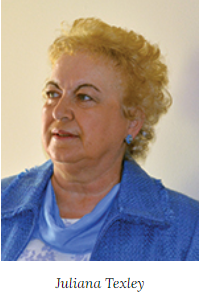
Einstein Adds a New Dimension is a rare science trade book that pairs a gripping narrative style with informative sidebars; hundreds of charts, maps, and diagrams; suggestions for further reading; and excerpts from the writings of great scientists. But how can teachers maximize its potential for classroom use?
Juliana Texley approaches Hakim’s book with the savvy of a K–12 science teacher with 25 years of classroom experience and offers educators supplementary materials to help seamlessly blend use of Einstein Adds a New Dimension with existing curricula. She even provides student activity pages.
The teacher and student materials found here are samples of what is available for Einstein Adds a New Dimension from NSTA.
Juliana Texley approaches Hakim’s book with the savvy of a K–12 science teacher with 25 years of classroom experience and offers educators supplementary materials to help seamlessly blend use of Einstein Adds a New Dimension with existing curricula. She even provides student activity pages.
The teacher and student materials found here are samples of what is available for Einstein Adds a New Dimension from NSTA.
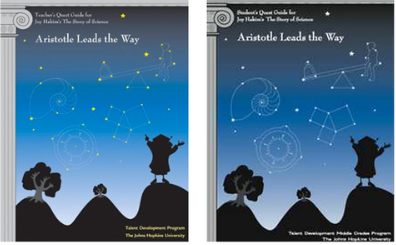
Teacher's and Student's Quest Guide: Aristotle Leads the Way (The Story of Science)
This rich, multidisciplinary curriculum to accompany Joy Hakim’s The Story of Science: Aristotle Leads the Way covers astronomy, physics, and chemistry from Mesopotamia to the Middle Ages. The course of study is divided into five units. Each unit includes an introduction (with background information, a materials list, and standards correlated to the narrative and teaching materials) and nine class sessions. The Teacher’s Quest Guide includes embedded reading strategies to facilitate greater comprehension, hands-on science experiments to encourage learning by discovery, timeline activities, and several review and assessment activities for each unit. Students will enjoy a time-traveling cartoon character, Professor Quest, who summarizes the main point of each lesson. Multiple cross-curricular links suggest additional activities in math, language arts, history, art, and other subjects to extend learning.
The accompanying Student's Quest Guide includes all necessary student worksheets. This curriculum is ideal for traditional science classes, enrichment programs, and home-school settings.
This rich, multidisciplinary curriculum to accompany Joy Hakim’s The Story of Science: Aristotle Leads the Way covers astronomy, physics, and chemistry from Mesopotamia to the Middle Ages. The course of study is divided into five units. Each unit includes an introduction (with background information, a materials list, and standards correlated to the narrative and teaching materials) and nine class sessions. The Teacher’s Quest Guide includes embedded reading strategies to facilitate greater comprehension, hands-on science experiments to encourage learning by discovery, timeline activities, and several review and assessment activities for each unit. Students will enjoy a time-traveling cartoon character, Professor Quest, who summarizes the main point of each lesson. Multiple cross-curricular links suggest additional activities in math, language arts, history, art, and other subjects to extend learning.
The accompanying Student's Quest Guide includes all necessary student worksheets. This curriculum is ideal for traditional science classes, enrichment programs, and home-school settings.
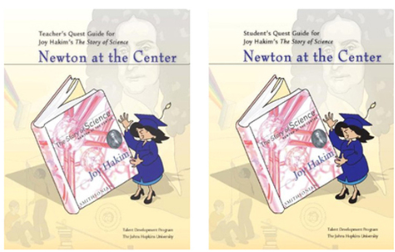
Teacher's and Student's Quest Guide: Newton at the Center (The Story of Science)
This rich, multidisciplinary curriculum to accompany Joy Hakim’s Newton at the Center covers astronomy, physics, and chemistry from Copernicus to the Curies, from the fifteenth to the twentieth centuries. The course of study is divided into seven units. Each unit includes an introduction (with background, materials list, and standards) and nine class sessions. The Teacher’s Quest Guide includes embedded reading strategies to facilitate greater comprehension; hands-on science experiments to encourage learning by discovery; timeline activities; several review and assessment activities for each unit; and even a time-traveling cartoon character, Professor Quest, to summarize the main point of the lessons. Multiple cross-curricular links suggest additional activities in language arts, history, art, and other subjects to extend learning.
The accompanying Student's Quest Guide includes all necessary student sheets. This curriculum is ideal for traditional physical science classes, enrichment programs, and home-school settings.
For an audio version of The Story of Science, click here.
This rich, multidisciplinary curriculum to accompany Joy Hakim’s Newton at the Center covers astronomy, physics, and chemistry from Copernicus to the Curies, from the fifteenth to the twentieth centuries. The course of study is divided into seven units. Each unit includes an introduction (with background, materials list, and standards) and nine class sessions. The Teacher’s Quest Guide includes embedded reading strategies to facilitate greater comprehension; hands-on science experiments to encourage learning by discovery; timeline activities; several review and assessment activities for each unit; and even a time-traveling cartoon character, Professor Quest, to summarize the main point of the lessons. Multiple cross-curricular links suggest additional activities in language arts, history, art, and other subjects to extend learning.
The accompanying Student's Quest Guide includes all necessary student sheets. This curriculum is ideal for traditional physical science classes, enrichment programs, and home-school settings.
For an audio version of The Story of Science, click here.
PBS created a TV series (with celebrity voiceovers) and an accompanying program for teachers based on A History of US.
Go to the PBS Freedom Teaching Website where you can view free Webisodes, read historical primers, browse teaching guides, and more.
To buy the DVD's, go to the PBS Teacher Shop
The gorgeous book, intended for classroom use and at home reading, is available from Social Studies School Services.
Go to the PBS Freedom Teaching Website where you can view free Webisodes, read historical primers, browse teaching guides, and more.
To buy the DVD's, go to the PBS Teacher Shop
The gorgeous book, intended for classroom use and at home reading, is available from Social Studies School Services.
The gorgeous book, intended for classroom use and at home reading, is available from Social Studies School Services.
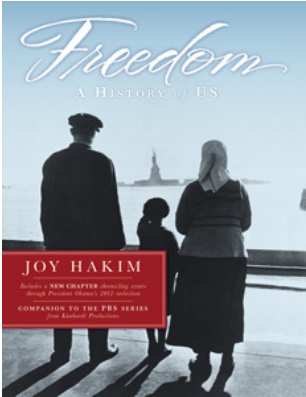
Freedom: A History of US and its incredible teaching resources
This is a readable one-volume U.S. history especially appropriate in middle and high school classes. Read the book, then explore a webisode at PBS.org and see why the promise of freedom has attracted millions of people to America. It is a story facing challenges today that can stimulate student research and inquiry.
To view all 16 webisodes of the terrific teacher/student website Freedom: A History of Us, please visit PBS.org/historyofus.
After watching the sixteen video Webisodes, CHECK OUT these games. You can have fun with the games and at the same time quiz yourself (or your students) on what you've learned:
This is a readable one-volume U.S. history especially appropriate in middle and high school classes. Read the book, then explore a webisode at PBS.org and see why the promise of freedom has attracted millions of people to America. It is a story facing challenges today that can stimulate student research and inquiry.
To view all 16 webisodes of the terrific teacher/student website Freedom: A History of Us, please visit PBS.org/historyofus.
After watching the sixteen video Webisodes, CHECK OUT these games. You can have fun with the games and at the same time quiz yourself (or your students) on what you've learned:
The Freedom: A History of US soundtrack
"Columbia Records/Legacy Recordings mined their rich archive of American recordings to prepare a unique, collectible boxed set that is the musical counterpart to PBS' chronicle of the struggle for freedom in our country. The 3-CD set Freedom: Songs From The Heart of America, along with a single-CD best-of collection, are part of a multi-media set of products inspired by the History of US book series by award-winning author Joy Hakim. Oxford University Press released Freedom: A History of US, a companion book to the PBS series; and PBS Home Video released the Freedom, television series on DVD and VHS." - Black Voice News
"Columbia Records/Legacy Recordings mined their rich archive of American recordings to prepare a unique, collectible boxed set that is the musical counterpart to PBS' chronicle of the struggle for freedom in our country. The 3-CD set Freedom: Songs From The Heart of America, along with a single-CD best-of collection, are part of a multi-media set of products inspired by the History of US book series by award-winning author Joy Hakim. Oxford University Press released Freedom: A History of US, a companion book to the PBS series; and PBS Home Video released the Freedom, television series on DVD and VHS." - Black Voice News
Freedom: Songs from the Heart of America
"This fabulous anthology’s creation was influenced by two equally defining factors: the eponymous eight-hour PBS documentary for which it serves as soundtrack, and the cultural wallpaper of the events of 9/11. Freedom's songs were compiled by Columbia/Legacy’s Grammy-tested quartet of Berkowitz, Brooks, Olds-Neal and Quaglieri, whose mission was clearly articulated and defined by Joy Hakim, creator of the documentary." - Seth Limmer, Pop Matters."This is a great collection with Nina Simone and others who will tear at your heart." J.H.
"This fabulous anthology’s creation was influenced by two equally defining factors: the eponymous eight-hour PBS documentary for which it serves as soundtrack, and the cultural wallpaper of the events of 9/11. Freedom's songs were compiled by Columbia/Legacy’s Grammy-tested quartet of Berkowitz, Brooks, Olds-Neal and Quaglieri, whose mission was clearly articulated and defined by Joy Hakim, creator of the documentary." - Seth Limmer, Pop Matters."This is a great collection with Nina Simone and others who will tear at your heart." J.H.
Ebook: "Reading Science Stories," uses Science and its stories as a way to Teach Critical ThinkingAll my books are intended as a way to get readers to think critically. The best way to do that? Get your students to write--every day if possible. Use the story format as a model for students to research, organize what they find into a narrative (fancy word for story), and write it out. Have them ask questions about what they've written and then answer their own questions. Do some more research (the web makes it easy). Rewrite. And again.
This book has compelling stories that are fun, easy to read and made for discussion.
This book has compelling stories that are fun, easy to read and made for discussion.
FREE TO BELIEVE (OR NOT) A book with original documents and stories of religious freedom in AmericaThis paperback book is intended as a way to teach original documents, which are often tough reading. But sometimes they are important. Here's a chance to read and teach them in context.
The Importance of Classroom Materials
A report from Brown Center on Education Policy at Brookings, called Choosing Blindly: Instructional Materials, Teacher Effectiveness, and the Common Core, by Matthew M. Chingos and Grover J. "Russ" Whitehurst, states:
"Students learn principally through interactions with people (teachers and peers) and instructional materials (textbooks, workbooks, instructional software, web-based content, homework, projects, quizzes, and tests). But education policymakers focus primarily on factors removed from those interactions, such as academic standards, teacher evaluation systems, and school accountability policies. It’s as if the medical profession worried about the administration of hospitals and patient insurance but paid no attention to the treatments that doctors give their patients.
There is strong evidence that the choice of instructional materials has large effects on student learning—effects that rival in size those that are associated with differences in teacher effectiveness. But whereas improving teacher quality through changes in the preparation and professional development of teachers and the human resources policies surrounding their employment is challenging, expensive, and time-consuming, making better choices among available instructional materials should be relatively easy, inexpensive, and quick."
For the complete report issued in April 2012, visit BROOKINGS Brown Center on Education Policy
A report from Brown Center on Education Policy at Brookings, called Choosing Blindly: Instructional Materials, Teacher Effectiveness, and the Common Core, by Matthew M. Chingos and Grover J. "Russ" Whitehurst, states:
"Students learn principally through interactions with people (teachers and peers) and instructional materials (textbooks, workbooks, instructional software, web-based content, homework, projects, quizzes, and tests). But education policymakers focus primarily on factors removed from those interactions, such as academic standards, teacher evaluation systems, and school accountability policies. It’s as if the medical profession worried about the administration of hospitals and patient insurance but paid no attention to the treatments that doctors give their patients.
There is strong evidence that the choice of instructional materials has large effects on student learning—effects that rival in size those that are associated with differences in teacher effectiveness. But whereas improving teacher quality through changes in the preparation and professional development of teachers and the human resources policies surrounding their employment is challenging, expensive, and time-consuming, making better choices among available instructional materials should be relatively easy, inexpensive, and quick."
For the complete report issued in April 2012, visit BROOKINGS Brown Center on Education Policy
The Importance of Exemplary Teachers
Wherever I go I meet superb teachers, I see them as national treasures. I'd like to celebrate them on this website
Mabel Morrill, who was my English teacher for two years at Rutland High School in Rutland, Vermont, changed my life and that of most of her students. She was tough, hardly anyone loved her, she wasn’t a loveable kind of person, but we all knew she was special and that she was not only teaching us to write, but to think well too. When I got my first book contract (with OUP) I sent a thank you note to Mrs. Morrill.
So I’m very aware of the power of good teaching. And, given what I now do, I know some wonderful teachers. I also know of terrific schools where there’s a culture of excellence along with the palpable excitement that comes when you know you are making a difference. Recently I spent time with a group of NCTE teachers. I was awed.
Great teachers, great principals, great librarians and others who devote themselves to teaching in its many forms are national treasures. Here are a few of my heroes. I’d be delighted to hear about others.
Wherever I go I meet superb teachers, I see them as national treasures. I'd like to celebrate them on this website
Mabel Morrill, who was my English teacher for two years at Rutland High School in Rutland, Vermont, changed my life and that of most of her students. She was tough, hardly anyone loved her, she wasn’t a loveable kind of person, but we all knew she was special and that she was not only teaching us to write, but to think well too. When I got my first book contract (with OUP) I sent a thank you note to Mrs. Morrill.
So I’m very aware of the power of good teaching. And, given what I now do, I know some wonderful teachers. I also know of terrific schools where there’s a culture of excellence along with the palpable excitement that comes when you know you are making a difference. Recently I spent time with a group of NCTE teachers. I was awed.
Great teachers, great principals, great librarians and others who devote themselves to teaching in its many forms are national treasures. Here are a few of my heroes. I’d be delighted to hear about others.

